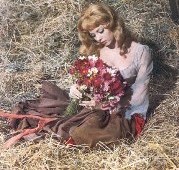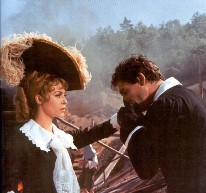
|
|
|
|
|
|
|
|
||||||||
Angélique (1964 - 1968): The conception of film
Angélique, the Marquise of the Angels (1964) - Angélique: The Road to Versailles (1965) - Angélique and the King (1966) - Indomitable Angélique (1967) - Angélique and the Sultan (1968)
 A skillful craftsman Bernard Borderie created the Angélique films already as an experienced director, who had rehearsed a similar theme with the movie The Three Musketeers (1961) or The Knights of Pardaillan (1962). The Borderie's movies are the best genre films of the sixties. However, the worldwide popularity of these films also contributed to be belittling the work of Anne Golon to a large extent.
A skillful craftsman Bernard Borderie created the Angélique films already as an experienced director, who had rehearsed a similar theme with the movie The Three Musketeers (1961) or The Knights of Pardaillan (1962). The Borderie's movies are the best genre films of the sixties. However, the worldwide popularity of these films also contributed to be belittling the work of Anne Golon to a large extent.
The contract for the first of the films was signed with producer Francis Cosne at the end of the year 1962. Two years later, a proven, genre director Bernard Borderie filmed the movie Angélique, the Marquise of the Angels, loosely inspired by the first part of one of the most successful French novels. For the main role, there ought to be originally cast somebody of the biggest stars of that era: Catherine Deneuve, Jane Fonda and Brigitte Bardot, who is in fact an enthusiastic reader of the Angélique's fates. During the legendary casting when Michèle Mercier showed a real explosion of anger, there was decided for a much smaller starlet to cast this role.  It turned out that Michèle Mercier was in her role extraordinary. Perhaps it was because the role of Angélique was tailored to meet for her, and corresponded to her existing experiences with film roles of the shameless women (see Shoot the Piano Player - Tirez sue le pianist, 1960; Black Sabbath - Tre volt della paura, 1963; La Pupa, 1963; The Thunder od God - Le Tonnerre de Dieu, 1965; La Seconde verité, 1966; The Oldest Profession - Le Plus vieux métier du monde, 1967). In addition, Michèle Mercier was never ordinary blonde. All her characters were affected by her innate and entirely self-evident haughtiness, and she shifted them thereby much higher. Thanks to this, twenty year old Michèle was getting the roles of the femme fatale and widows, which would otherwise have been determined for the aloof older ladies. The actress then basically played herself alone, and such a figure of Angélique was too resembling her. What is then valid to Michèle to scream that she isn't Angélique, and to the author of novel that the Angélique by Mercier isn't "real"? Whether we like or not, from the moment we look at the Borderie's film, the face of Michèle Mercier becomes some kind of Angélique's face for us. Perhaps only those who have never seen any of the Angélique movies, are not affected by this obtrusive picture of a bit of a blond little redhead Countess from the 17th century with black eyeliner which were worn in the sixties.
It turned out that Michèle Mercier was in her role extraordinary. Perhaps it was because the role of Angélique was tailored to meet for her, and corresponded to her existing experiences with film roles of the shameless women (see Shoot the Piano Player - Tirez sue le pianist, 1960; Black Sabbath - Tre volt della paura, 1963; La Pupa, 1963; The Thunder od God - Le Tonnerre de Dieu, 1965; La Seconde verité, 1966; The Oldest Profession - Le Plus vieux métier du monde, 1967). In addition, Michèle Mercier was never ordinary blonde. All her characters were affected by her innate and entirely self-evident haughtiness, and she shifted them thereby much higher. Thanks to this, twenty year old Michèle was getting the roles of the femme fatale and widows, which would otherwise have been determined for the aloof older ladies. The actress then basically played herself alone, and such a figure of Angélique was too resembling her. What is then valid to Michèle to scream that she isn't Angélique, and to the author of novel that the Angélique by Mercier isn't "real"? Whether we like or not, from the moment we look at the Borderie's film, the face of Michèle Mercier becomes some kind of Angélique's face for us. Perhaps only those who have never seen any of the Angélique movies, are not affected by this obtrusive picture of a bit of a blond little redhead Countess from the 17th century with black eyeliner which were worn in the sixties.
|
The screenplay has already digressed from the original novel at its outset, and was aimed at using of superficial scheme of the commercially successful films of (not only) the sixties, containing the necessary dose of voltage, number of action scenes, violence and eroticism. Nevertheless, the finished movie was still very strong and in a certain way unusual thanks to the chosen novel. There was also very helpful the music by Michel Magne, and the attractive exteriors which, however, were absolutely out of the realities.
Under a strict look, the literary work and the subsequent film works have a common only the names (not personalities) of the main characters, and the plot of the first plan. The Mercier's Angélique is infinitely distant from the book heroine with a spiritual essence, from a free woman loving nature and experiencing deep feelings. You could say that the portrayed personality of popular movie heroine fell in a superficial and lascivious coquette of low-level who is only playing with men but nothing really intervenes her. After all, Angélique of a movie became even a murderess in the episode Angélique and the King (Angélique et le Roy, Bernard Borderie, 1966). However, this concept of Angélique was a variation on the sex symbol recently determined in the phenomenon of Brigitte Bardot, and was completely in line with the socio-cultural revolutionary sixties. Therefore the Angélique movie also remains the legend of its kind, and for its appreciation, there is needed not to do classify this work to a historical movie, but enjoy a metaphor to the model of "new woman" and a big symbolism.  It's not a typical historical-adventure romance but one of the cultural manifestations of the sixties, when the unsmiling but constantly feminine heroine is the embodiment of a new epoch, is the embodiment of a woman, in who the abilities blend with a naivety, false perversity, cruelty and selfishness of a child. The filmmakers also focused on a number of scenes which give the powerful erotic impression precisely because they are only indicated, and require the viewer's imagination. Who had an idea in the time before the year 1964 when there appeared this concept of Angélique in the cinemas for the first time, that somebody is going to use the name Angélique as the name for a beauty parlor, a bed or a collection of underwear? The names Angélique, or also Angelica or Angeline were used very few before, perhaps still in the environment of convents. The film heroine Angélique has become a cult title. The movie and the historical novel, they both remain a successful phenomena comparably but simultaneously also the most different worlds, as it happens in the case of adaptation sometimes.
It's not a typical historical-adventure romance but one of the cultural manifestations of the sixties, when the unsmiling but constantly feminine heroine is the embodiment of a new epoch, is the embodiment of a woman, in who the abilities blend with a naivety, false perversity, cruelty and selfishness of a child. The filmmakers also focused on a number of scenes which give the powerful erotic impression precisely because they are only indicated, and require the viewer's imagination. Who had an idea in the time before the year 1964 when there appeared this concept of Angélique in the cinemas for the first time, that somebody is going to use the name Angélique as the name for a beauty parlor, a bed or a collection of underwear? The names Angélique, or also Angelica or Angeline were used very few before, perhaps still in the environment of convents. The film heroine Angélique has become a cult title. The movie and the historical novel, they both remain a successful phenomena comparably but simultaneously also the most different worlds, as it happens in the case of adaptation sometimes.
|